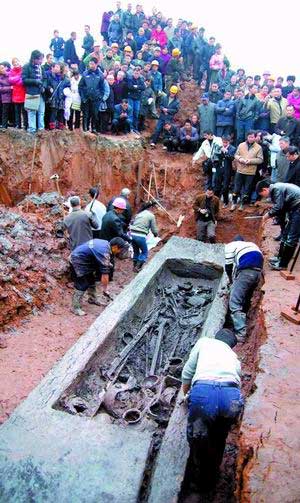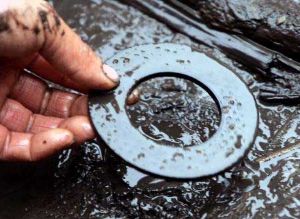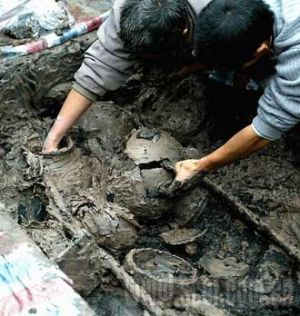| Tools: Save | Print | E-mail | Most Read |
| 2,500-year-old Boat Coffin Reveals Hidden History |
| Adjust font size: |
With abundant cultural relics, a boat-shaped coffin dating back nearly 2,500 years has been unearthed in Feilong Village near Heshan Town in Sichuan's Pujiang County, raising expectations that it may reveal the true history of a long-lost kingdom in the area. Located in a construction site, the coffin was discovered on December 5 by workers when conducting mud-digging 1.5 meters deep underground. Pujiang County was part of the Shu Kingdom, which has remained mysterious because no written record remains of its history and culture from 2,500 years ago. According to Liu Yumao, an expert from the Chengdu Institute of Archaeology, the coffin, belonging to the Warring States Period (475-221 BC), was made of a seven-meter-long rare wood material nanmu with a diameter of 1.6 meters. The wood was cut into halves and hollowed out in the middle where the dead body and funerary objects were laid. The archaeologists discovered two bronze kettles and "duns" beside the coffin, and a number of broken bronze wares believed to be fragments of the bronze kettles and "duns." Bronze kettles and "duns" were wine vessels in the Warring States Period and seldom unearthed before in Sichuan Province, said Liu. "Judging from the appearance, they bear obvious characteristics of the culture of Chu State and probably come from the provinces of Hubei and Hunan." These bronze wares were never possessed by ordinary families, making the tomb likely to belong to a noble family in the Shu Kingdom, according to Liu. After lifting the coffin cover weighing several tons with the help of a crane, archaeologists found that much mud was deposited in the coffin due to a square hole cut by robbers in the cover. Hundreds of funerary objects were found in the coffin, including bronze ware, lacquerware, pottery ware and wood ware, believed to be the largest such find in China. "The pieces of lacquerware are amazing," said Jiang Cheng, deputy director of Chengdu Institute of Archeology. "Its wood and bamboo kinds are vivid in color and exquisite in figure." Only accessible to nobles with high status, the lacquerware is quite precious in the Warring States Period, the value of which could equal to bronze wares, according to Jiang. Archaeologists also discovered spears, knives, rings and swords inside the coffin, all made from bronze. Large amounts of plant seeds and kernels were also unearthed. By putting plant seeds and kernels in the coffin, ancient people hoped the dead could enjoy an affluent life in the other world, said Jiang. Botanists will conduct research to identify the kinds of seeds, Jiang said. The historical relics also included a well preserved wood comb, a bridge-shaped coin, a black jade and a coin-sized seal of "Bashutuyu." The coin-sized "Bashutuyu," discovered when the archaeologists were cleaning up the silt under the coffin, is a bronze seal with symbols similar to "King" in seal characters on both sides and bud-like veins running along the top and bottom, said Jiang. The seal, also discovered in Sichuan's Xuanhan and Xingjing counties before, remains a riddle in Chinese archaeology, said Liu. "The controversy now focuses on whether they are mysterious characters in ancient Ba and Shu areas, or primitive symbols of wizardry, or marks to distinguish different families." Ba and Shu areas refer to two ancient states in present Sichuan Province. The Ba people lived around the provincial capital of Chengdu, and the Shu people lived around Chongqing. "A series of archaeological discoveries manifested that ancestors in Ba and Shu areas had enjoyed a developed civilization prior to Qin Dynasty (221-206 BC), but no records have been found to explain it." "If we work out the seal, we can reveal the riddle, which is of great significance to understand the origin and development of the Ba-Shu culture," Liu said. The bridge-shaped bronze coin dating back to the Spring and Autumn Period (770-476 BC) and Warring States Period is quite rare. It takes on the shape of a half-ring with tilted veins, and carved with checked veins. The coin was named "bridge coin" as it resembled China's traditional stone bridge, Jiang said. Besides the coin were several bronze coins in currency during the Warring States Period, cast with the two Chinese characters ban liang. The black jade, with a diameter of 10 centimeters and bud-like veins on the surface, was the last one unearthed. Jades were exclusive to nobles in ancient China, which further proved that the tomb master was a noble from the Shu Kingdom, according to Liu. According to Long Teng, an archaeologist from the local institute of cultural relics management, the most valuable item unearthed from the coffin is a 2.1-meter-long wooden quant, marked with colored drawings. "It was the same with modern quants," Long said, adding that the discovery is helpful to resolve a controversy whether the coffin should be called "boat coffin" or just simply "wood coffin." Many experts preferred the "boat coffin," but they had no evidence until the discovery of the quant. "With the further archaeological excavation, more boat-shaped coffins will be discovered in this area," the expert said. Boat-shaped coffins were used in burial rituals, peculiar to the ancient Ba-Shu area. "The discovery is of great value to the study of the origin and development of culture as well as economic exchanges of the Shu Kingdom, he said. Historical records show that the people of the Shu Kingdom lived along rivers and boats were part in their lives, explaining their preference for boat-shaped coffins for burial, the expert said.
(Xinhua News Agency December 15, 2006) |
| Tools: Save | Print | E-mail | Most Read |
 |
| Related Stories |
|





